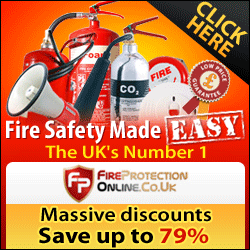
CO2 Fire Extinguishers
CO2 fire extinguishers (carbon dioxide) are the only fire extinguisher recommended for fires involving electrical equipment. CO2 is safe to use on and around electrical equipment, as the gas itself is non-conductive, and once used, there is no sticky foam or messy powder left behind. They are also effective on Class B fires (flammable liquids). Carbon dioxide fire extinguishers are painted bright red with a black panel above the operating instructions. They have a distinctive horn-shaped nozzle at the side on the smaller models with 5kgs and … [Read More...]

Water Extinguishers
Water remains one of the most effective fire-extinguishing agents we have, from the humble fire bucket to today's more sophisticated water fire extinguishers. Water extinguishers should only be used where they work best, on Class A fires, sometimes called ordinary combustible fires. Paper, wood, fabrics, furniture, indeed most things you'll have stored in your home or office, will provide the fuel for a Class A fire. A water fire extinguisher is solid red in colour, unless your premises have invested in designer stainless steel … [Read More...]

Water Additive Extinguishers
Chemical additives can radically increase the effectiveness of a water fire extinguisher by up to 300%, as well as reducing the size of extinguisher required. Water additive fire extinguishers, often referred to by Chubb Fire's brand name of Hydrospray, are smaller and lighter than standard water fire extinguishers. A 3 litre Hydrospray Elite extinguisher matches the 13A rating of an ordinary 9 litre water extinguisher and, if you have ever picked up a 9 litre extinguisher, you'll understand the benefit. A 6 litre water additive will … [Read More...]

Dry Powder Extinguishers
Dry powder fire extinguishers are excellent all-round fire extinguishers, often recommended for use on vehicles and in the home. All powder fire extinguishers are red with a blue panel, are either ABC or BC rated and are safe to be used on fires involving electrical equipment. (Remember to look for the electrical safety pictogram.) Dry powder extinguishers are not suitable for use in enclosed spaces such as offices, hotels, schools, etc, as the fire-fighting agent creates a cloud that can obscure vision. The contents may also create … [Read More...]

Foam Fire Extinguishers
Foam fire extinguishers have come a long way in 30 years. The original foam was thick, gloopy and smelled appalling, due to its high animal protein content. (Not good for vegetarians, then!) Modern Aqueous Film Forming Foam (AFFF) fire extinguishers are another breed altogether, one of the best all-round units available. Foam extinguishers are red with a cream panel above the operating instructions. How Aqueous Film Forming Foam (AFFF) Fire Extinguishers Work When sprayed onto a fire, AFFF foam (pronounced A-triple-F) extinguishes and … [Read More...]

Wet Chemical Extinguishers
Wet chemical fire extinguishers are the new kids on the fire extinguisher scene, developed specifically for use on deep fat cooking fires. The first such extinguisher on the market was the Chubb FryFighter, and its appearance gave rise to a new fire class, Class F and a new British Standard, BS 7937: 2000. Wet chemical fire extinguishers are red with a yellow panel above the operating instructions. How Wet Chemical Fire Extinguishers Work Normal fire extinguishers are worse than useless in a deep fat fire, since they cannot cool … [Read More...]

Extinguishers For Metals
Specialist fire extinguishers are required to tackle Class D flammable metal fires. As you might expect when dealing with such volatile and specialist materials, you need the correct agent for the metal being extinguished. However, flammable metals are more common than you might imagine, as under certain conditions, even powdered aluminium or swarf can catch fire. All powder-based specialist fire extinguishers designed for fighting metal fires are categorised as a powder extinguisher, so are coloured red with the familiar blue panel above … [Read More...]










Recent Comments